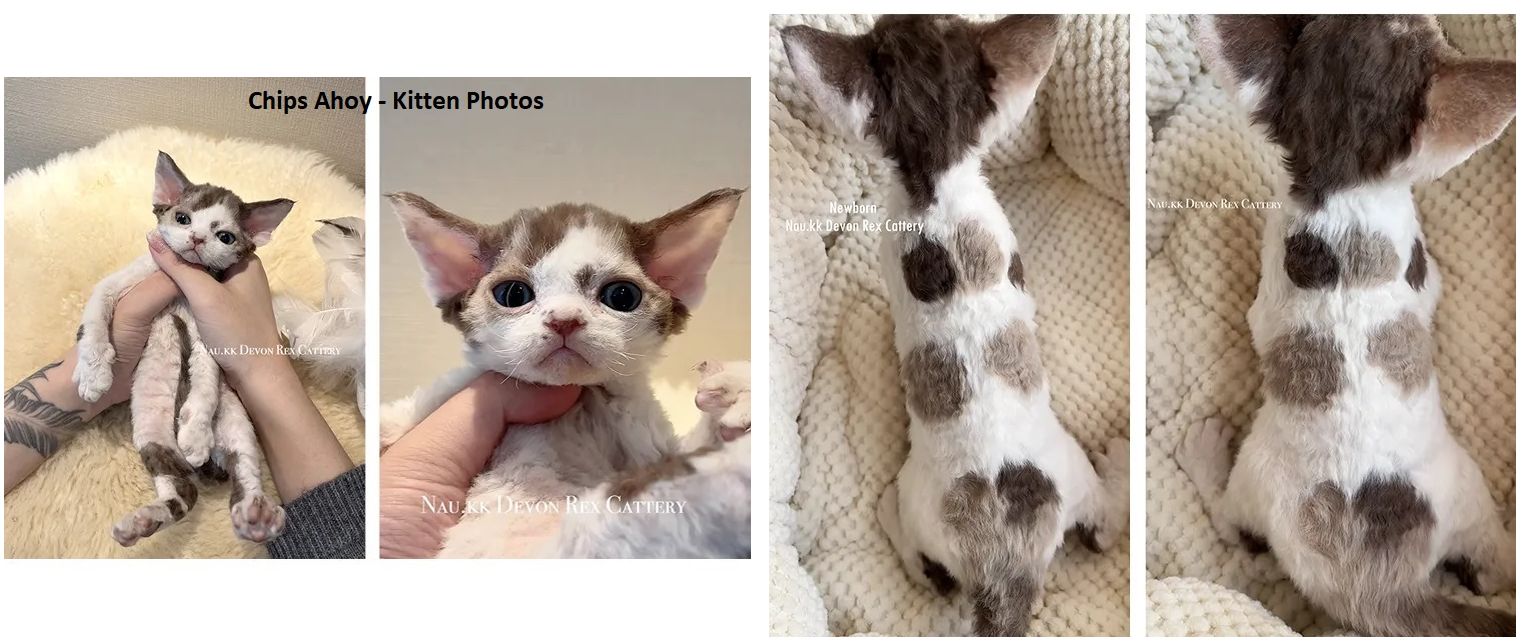
CHIPS AHOY: A CHIMERA INVESTIGATED BY PETGENO LABORATORY, CHINA
In February, PetGeno came across a highly popular Devon Rex online, with unusual markings on its back. The Devon Rex in question was a male named "Chips Ahoy" from NAUGHTY KKKY cattery.

GUESS THE GENOTYPE!
Intrigued by the cat's genetically impossible colours and pattern, PetGeno looked at the phenotype and possible genotype of this cat. After much discussion they couldn't reach a consensus so they decided to get hold of the little fellow to run some genetic tests.
When they first laid eyes on Chips Ahoy, they were puzzled because this was a cat with conflicting appearances:
Contradiction 1: The two symmetrical patches on Chips Ahoy's shoulders create a tortoiseshell-like effect, but he is a black-based male cat, and black-based cats do not typically appear as two colours simultaneously.

The contrast between the light and dark patches on Chips Ahoy's shoulders and the tortoiseshell red-black patches.
Contradiction 2: The non-white areas on Chips Ahoy's face and torso appeared to be solid-coloured (without patterns), while faint patterns could be seen on his head and tail, adding a touch of mystery to Chips Ahoy's Agouti gene.

Unpatterned vs Patterned
FIRST SAMPLE SUBMISSION: ORAL SAMPLE COLLECTION AND RESULTS
Luckily, the breeder of Chips Ahoy, owner of "NAUGHTY KKKY" cattery, was very helpful and was also a Petgeno customer. Chips Ahoy's oral swab sample was shipped out for testing on the same day the lab contacted his owner.
After several laboratory procedures including nucleic acid extraction, machine testing, and data interpretation, the result obtained was: “Sample Contaminated.” The reason for sample contamination is the detection of DNA from two or more cats in a single submitted sample. This can come from various sources, for example, failure to isolate the pet before sampling or contamination of the sampling swabs with DNA from other cats. The breeder of Chips Ahoy strictly followed the procedures for isolation and sampling. After excluding these as possible causes of sampling fault, the clue lead to another speculation: could Chips Ahoy be a chimera?
WHAT IS A CHIMERA?
In Greek mythology, the "Chimera" was a fire-breathing creature with the head of a lion, the body of a goat, and the tail of a serpent. Over the centuries, the term "chimera" has come to describe any fictional creature with body parts taken from various animals. In Genetics, a chimera refers to an individual that has a mixture or blend of different hereditary traits. This means having two or more sets of chromosomes (two distinct cell lines) coexisting in one organism. Chimerism occurs when to fertilised eggs merge in the womb. It is not hereditary.
Natural chimerism is documented in humans. In the late 20th Century, a suspicious man took his son for paternity testing. The results showed that his son was actually his brother's child, but the father didn't have a brother. A thorough examination of the father revealed that he was originally part of a pair of non-identical twins (2 separate eggs fertilised by different sperm). While the embryos were just balls of undifferentiated cells, they had merged and developed as a single embryo containing two cell lines. The father was a chimera – non-identical twins in a single body - and his child had the genes from his "brother."
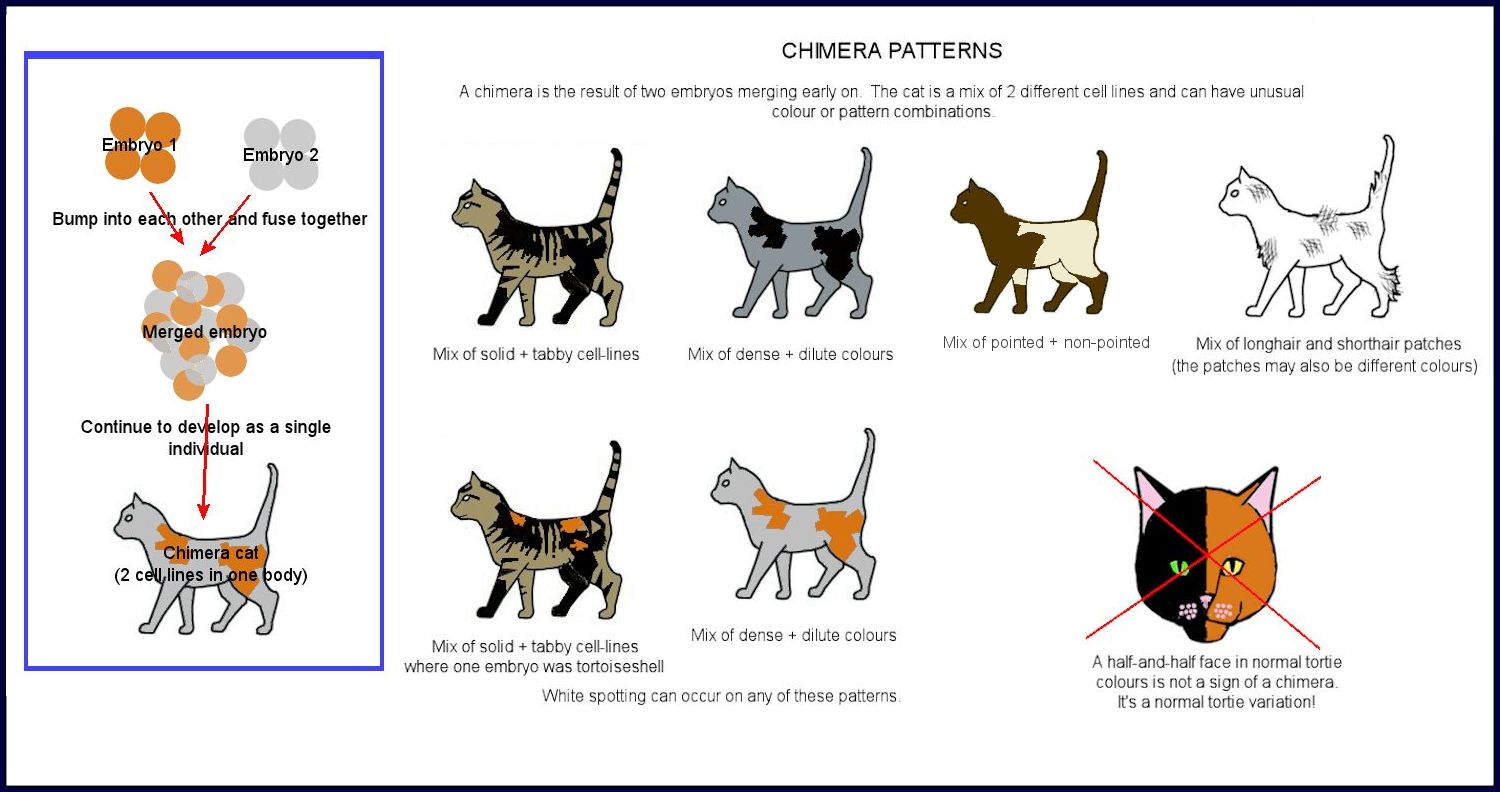
FURTHER SAMPLE SUBMISSION: SECTIONAL COLLECTION OF HAIR SAMPLES.
Based on the phenotype of Chips Ahoy and the issue of oral sample contamination, PetGeno suspected that Chips Ahoy was a chimera kitten. However, proving a chimera is quite challenging. Chimerism is highly random, and even with sectional collection of hair samples, it's possible to obtain contaminated results due to the high degree of fusion of the two cell lines. Nevertheless, they communicated with Chips Ahoy's breeder. To their pleasant surprise, the breeder was very understanding and willing to cooperate further.
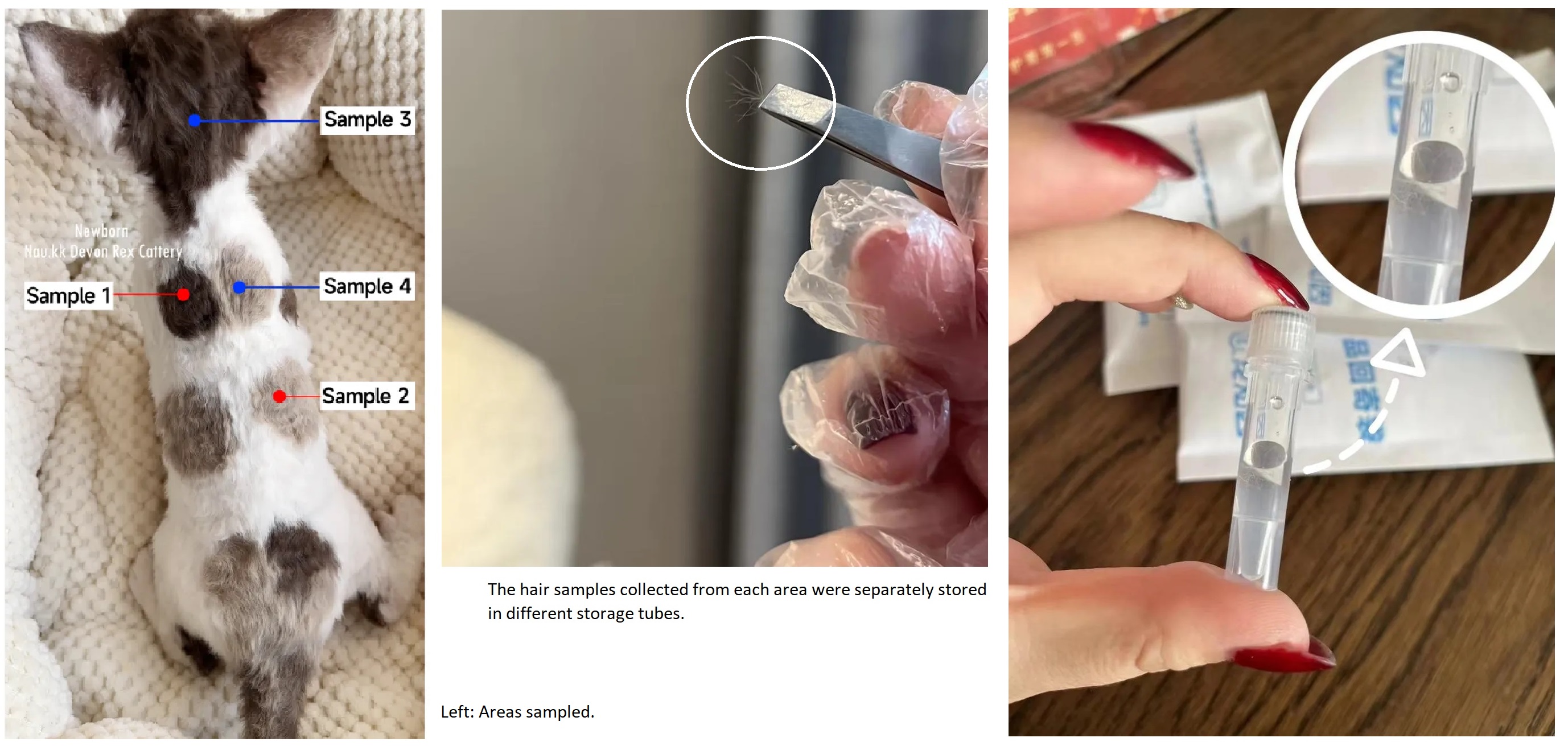
The lab highlighted several areas for investigation and labelled these as Areas 1, 2, 3, and 4. The owner collected hair samples separately from these four areas of Chips Ahoy.
The results of the four samples were as follows:
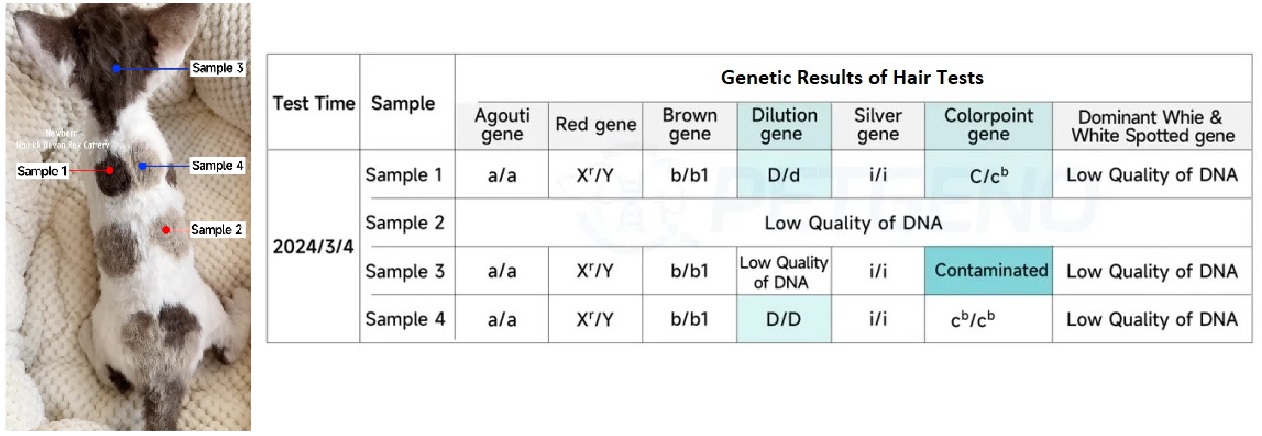
DR. WANG'S INTERPRETATION

Sample 3: signs of contamination, likely due to the less prominent effect of the Burmese Colourpoint gene on the head, resulting in unclear boundaries between the two phenotypes of the chimera. This makes the sampling process prone to contamination.
Sample 2: low quality of DNA.
The samples that met the requirements for testing were samples 1 and 4. Sample 4's result is D/D, cb/ cb. Sample 1's result is D/d, C/cb.
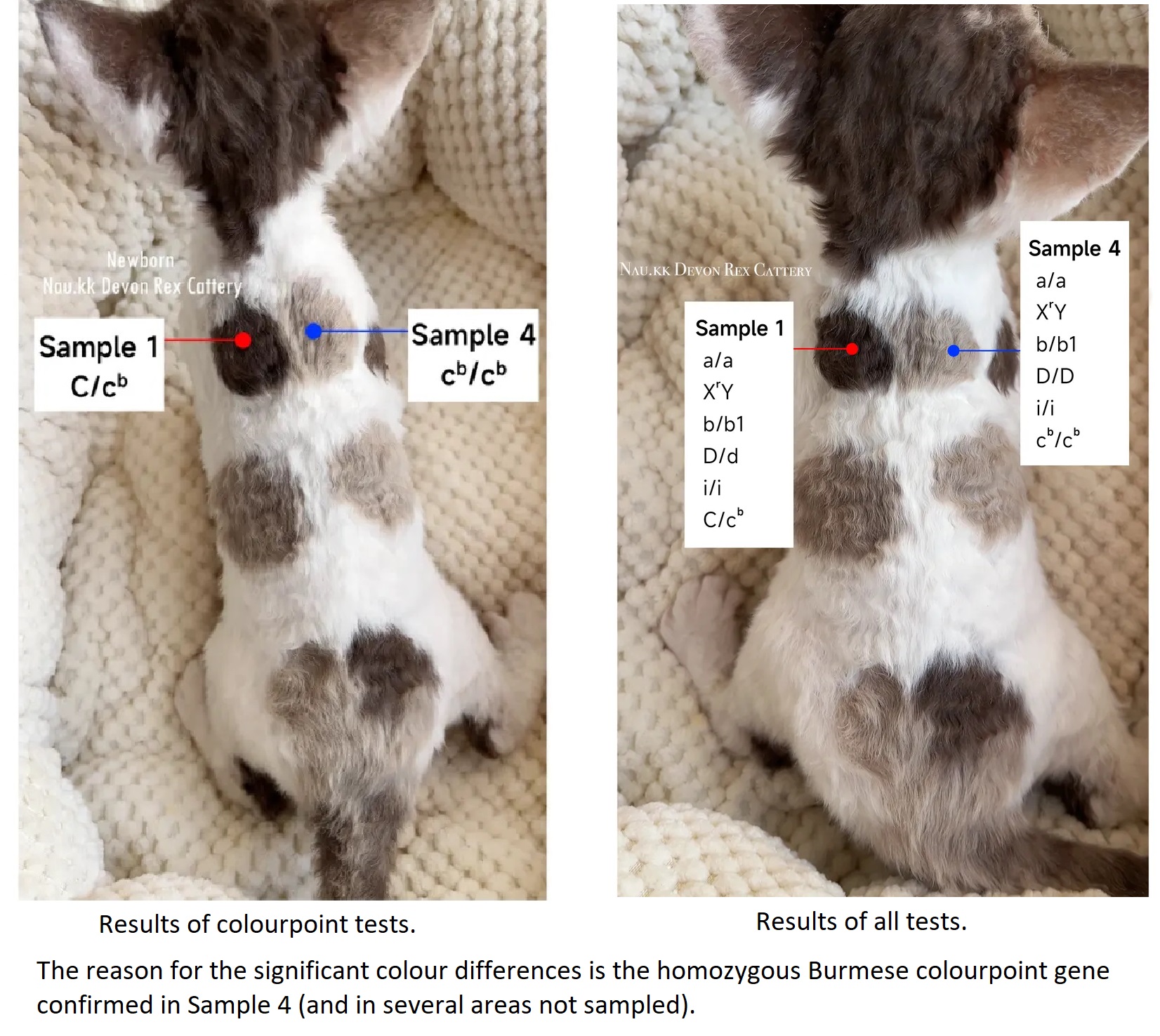
Due to the higher requirement of DNA quality for testing for Dominant White vs White Spotting gene, Samples 1 and 4 did not meet the requirements.
In the most contrasting area, the shoulders (Samples 1 and 4), the genotypes of Dilution gene and Colourpoint gene were different. This directly proved that the DNA from these two areas came from different individuals:
- The genotypes of the Dilution gene are D/D and D/d. Although there are differences, they do not cause hair color differences.
- The reason for the significant difference in fur color is Colorpoint gene. Sample 4's result is cb/cb, appear as a pointed color effect, while sample 1 is C/ cb, which does not have colorpoint.
Meanwhile, Chips Ahoy perfectly demonstrates the effect of temperature on Colorpoint gene. Samples 1 and 4, located on the body trunk where the subcutaneous fat layer is thicker and the temperature is higher.
- Due to the genotype of sample 1 being C/ cb (non-pointed), the synthesis of melanin is not affected by temperature, so it appears as the original chocolate color.
- Whereas the genotype of sample 4 is cb/ cb (sepia pointed), the synthesis of melanin is inhibited at higher temperatures, resulting in a light brown color.

(1) Parents. (2) Comparison between Chips Ahoy's baby v.s. Kitten stages.
We can see that the light-colored hair on Chips Ahoy's face is gradually darkening as it grows. The following image shows a comparison of newborn and one-month-old pointed cats, demonstrating the color changes of three different colorpoints.
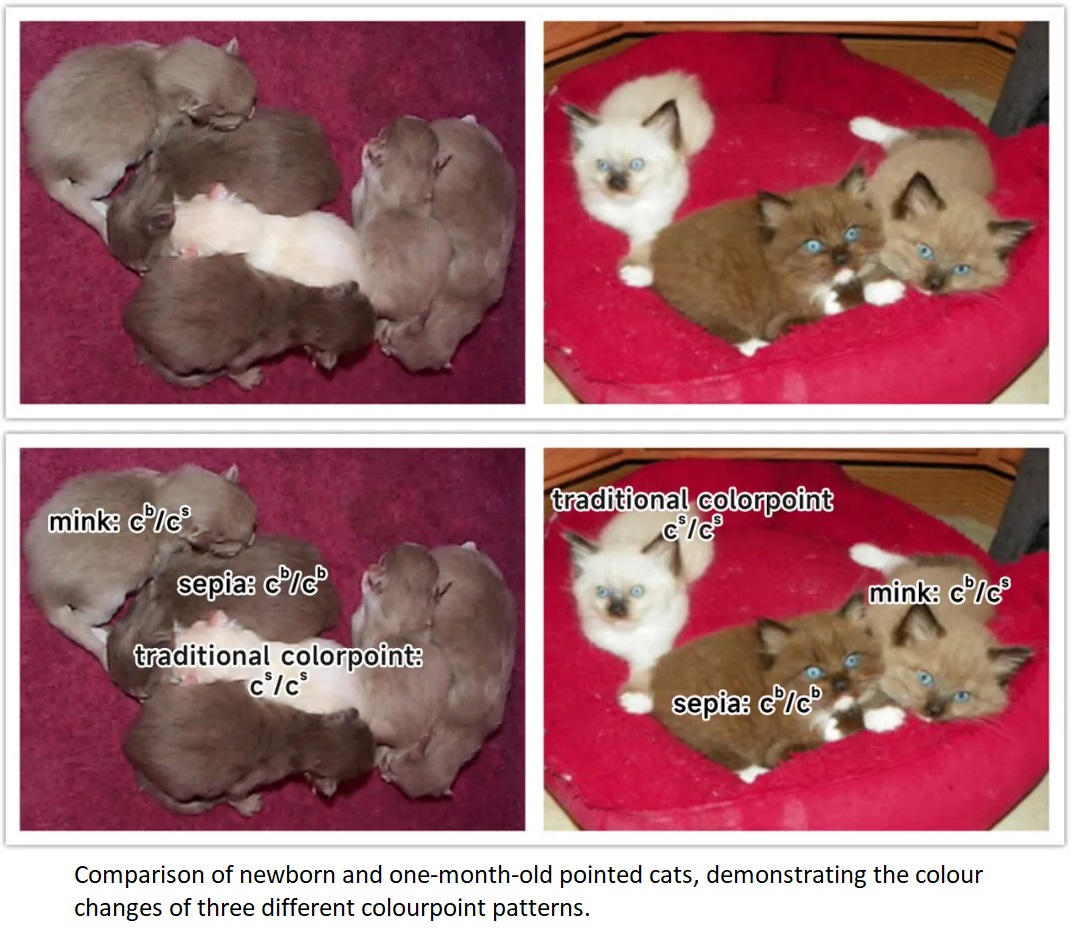
WHY WOULD ORAL SAMPLES FROM A CHIMERA BE CONTAMINATED?
Now we can explain why Chips Ahoy's oral sample was contaminated.
The fusion sites (boundaries) of a chimera are random, and can occur at any location and at multiple locations. Coincidentally, Chips Ahoy's oral cavity was where fusion occurred. Therefore, when collecting Chips Ahoy's oral cells, samples from two cats' DNA were collected simultaneously, leading to the first sample submitted being contaminated.
CHIPS AHOY'S HAIR COLOUR RESULTS
Sample 1's genotype for Agouti gene is a/a, for Red gene is XrY, for Brown gene is b/b1, for Dilution gene is D/d, for Silver gene is i/i, and for Colorpoint gene is C/ cb. Therefore, this part of the fur color is not pointed, but undiluted solid chocolate.
Sample 4's genotype for Agouti gene is a/a, for Red gene is XrY, for Brown gene is b/b1, for Dilution gene is D/D, for Silver gene is i/i, and for Colorpoint gene is cb/ cb. Therefore, this part of the fur color is chocolate sepia colorpoint.
The contamination phenomenon of Dilution gene and the combined locus of Colorpoint gene in area 3 is also due to the presence of both fur types expressing sample 1 and sample 2 in this area.
Chips Ahoy's fur color genetics mystery was solved! This was indeed a very precious example of a chimera case!
ABOUT PETGENO
(Petgeno laboratory is located in Beijing, China and has been providing trusted DNA test services for pet breeders and owners worldwide since 2012. Petgeno is focused on DNA testing of inherited diseases and appearance traits of companion animals. The laboratory is a product of a young, expert and passionate team connected by love of science and animals and concern for their safety, health and wellbeing. For further information about the Petgeno laboratory, services and technologies: service@catdogtest.com for inquiry (English and Chinese) )